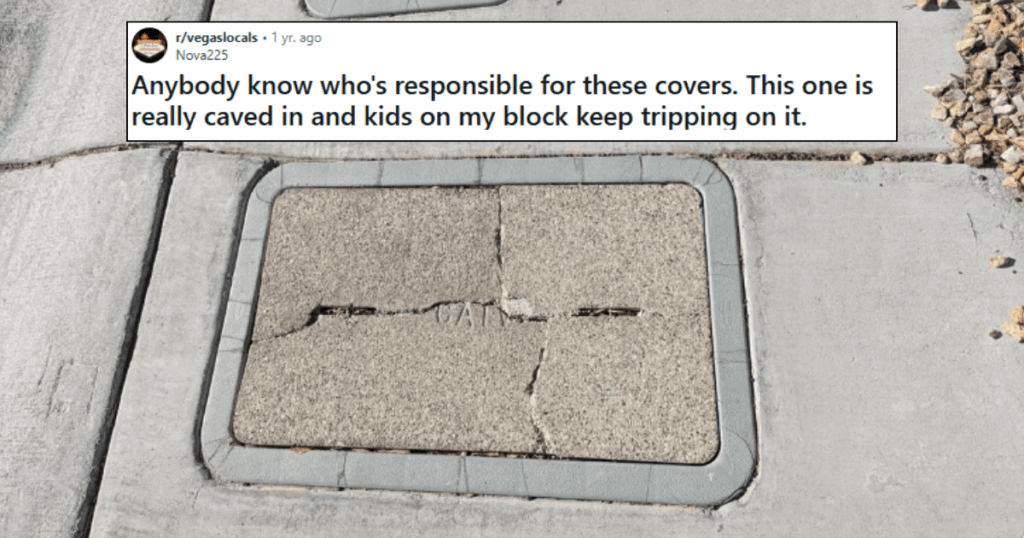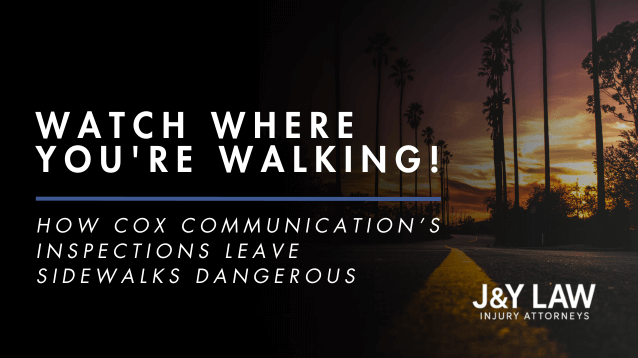Watch Where You’re Walking! How Cox Communication’s Inspections Leave Sidewalks Dangerous
Sidewalks in California and across the country are dotted with metal, concrete, or plastic vault covers. These covers provide access to underground cable lines owned or maintained by utility companies like Cox Communications.
When properly installed and maintained, vault covers should be flush with the sidewalk, slip-resistant, and secure. But when they become broken, loose, or slippery, they turn into trip-and-fall or slip-and-fall hazards. For pedestrians, that can mean devastating injuries: traumatic brain injuries, spinal fractures, or lifelong chronic pain.
Cox, one of the largest cable companies in the nation, is no stranger to lawsuits involving these hazards. In fact, court records suggest that roughly 30% of cases against Cox involve vault lid failures. Despite this, Cox relies on annual drive-by inspections that miss hazards in the months between. The result is a public safety crisis hiding in plain sight on our sidewalks.
How Common Are Injuries From Cox Vault Covers?
Unfortunately, these incidents are far from rare. Across the country, people continue to be injured by broken or unstable Cox vault covers.
Take one California case in San Diego: a woman tripped on a broken cable vault lid and developed Complex Regional Pain Syndrome, a severe, lifelong condition. Attorneys noted that both the city and the communications company ignored the hazard for far too long.
Online forums like Reddit also feature posts from frustrated residents sharing photos of cracked, missing, or uneven vault covers they nearly trip over on their daily walks. These everyday accounts make it clear that this isn’t an isolated problem, but a recurring safety issue.
“We’re currently representing a woman who fell through a Cox vault lid embedded in the sidewalk,” says Parham Nikfarjam, Senior Trial Attorney at J&Y Law. “She fractured her neck and suffered a traumatic brain injury. She’s still fighting every day to reclaim her life. This wasn’t a freak accident, either. It was a foreseeable outcome of a visible hazard. If Cox had taken safety seriously, she wouldn’t be living with permanent injuries today.”

For a free legal consultation, call (424) 453-2310
Why Do Annual Drive-By Inspections Fail to Protect the Public?
Cox’s primary defense is that it complies with industry standards. But what exactly does that mean?
In many cities, compliance amounts to one annual “drive-by inspection.” A Cox truck drives through neighborhoods and technicians look out the window for visible hazards.
The problems with this system are obvious:
- Hazards can appear the day after an inspection. Weather, vandalism, or simple wear can loosen or break a lid.
- Drive-bys miss defects that aren’t visible from the road, such as lids that rock when stepped on or become dangerously slippery when wet.
- The public is left exposed for months until the next inspection—or until someone gets hurt.
“Annual drive-bys aren’t safety,” claims Nikfarjam. “They’re compliance theater. We’ve been here before, and we’ll be here again until real inspection standards replace these drive-through charades.”
How Does Cox Use Legal Loopholes to Avoid Responsibility?
Even when someone is injured, victims often face an uphill legal battle. Why? Because Cox and other utilities exploit ownership ambiguities to delay or deny liability.
In Crown Castle litigation in California, courts noted that sidewalk maintenance duties can fall into legal gray zones depending on who installed or permitted the vault.
This ambiguity leaves victims in a cruel bind: they must first prove ownership before even proving negligence. Meanwhile, the hazardous cover often remains in place.
Without clear ownership markings or public databases of utility vaults, companies like Cox can hide behind technicalities, leaving injured pedestrians in legal limbo.
Click to contact our personal injury lawyers today
Who Is Most at Risk From Cox Sidewalk Hazards?
The injuries don’t fall evenly across society. Vulnerable groups are hit hardest:
- Seniors in retirement communities: In Louisiana, residents begged Cox to remove an exposed cable lying across a sidewalk for almost a year. They feared their elderly neighbors – some in their 90s – would fall.
- Children walking to school: In Seattle, a first grader wrote to the city after slipping on a wet utility vault cover outside his school. He described it as “like walking on a slide.” If a child can see the danger, why not the utility responsible?
- Workers themselves: Even Cox technicians are injured. One worker in Louisiana hurt his back trying to lift a vault cover that was far too heavy.
These are predictable dangers that disproportionately threaten the people who rely on sidewalks the most. As a society, we have a responsibility to protect our most vulnerable by making sure public infrastructure is not just accessible, but safe.
Complete a Free Case Evaluation form now
What Do the Laws Say About Sidewalk Vault Safety?
California cities already have codes recognizing the risk:
- Sacramento City Code 12.12.230 requires vaults in sidewalks to be flush, slip-resistant, and safe for public use.
- San Francisco Public Works Code 790 imposes slip-resistance requirements based on the strictest available standards, with fines up to $500 per day for noncompliance.
- California Streets & Highways Code 5610 requires sidewalks to be maintained in safe condition, though companies often argue this duty belongs to cities, not utilities.
The reality is uneven enforcement. Some municipalities demand safe, slip-resistant lids; others allow Cox to get by with annual inspections. Without uniform enforcement, Cox complies with the lowest bar possible.
How Much Do Slip-and-Fall Injuries Cost Society?
The economic toll of sidewalk hazards is staggering:
- Slip-and-fall incidents cost the U.S. $60 billion annually.
- Each incident averages $48,000 in direct costs and causes an average of 14 lost workdays.
- Beyond the financial numbers, the human cost is immeasurable: TBIs, permanent disability, and the emotional toll of losing independence.
These costs dwarf the price of preventive measures. Upgrading to slip-resistant lids or performing quarterly inspections costs a fraction of what one lawsuit settlement or hospital bill does.
What Solutions Could Prevent Cox Sidewalk Hazards?
These aren’t radical fixes. They’re the same standards cities already use for traffic signals, crosswalks, and road safety:
- Quarterly or Monthly Inspections: Instead of annual drive-bys, Cox should be required to perform frequent, documented inspections.
- Improvement-Based Standards: Regulators should track whether hazard reports decline over time, not just whether inspections occurred.
- Slip-Resistant Lids: Modern designs meet traction standards that reduce slip risks, even in rain.
- Clear Ownership Markings: Every cover should display the utility’s name and a contact number, with data logged in a citywide database.
- Enforcement With Teeth: San Francisco fines $500 per day for noncompliance, for example. Other cities should adopt similar penalties.
- Public Reporting: Cities should empower residents to report hazards through 311 apps, forcing utilities to respond quickly.
Why should sidewalks be treated as second-class infrastructure when they are the lifeblood of pedestrian communities? It’s a question that demands an answer.
Why Is Cox Still Allowed to Do the Bare Minimum?
That is the central question. Cox knows these hazards are common. Its own technicians carry spare lids! Yet the company clings to annual drive-by inspections as proof of safety.
Regulators, meanwhile, let utilities define compliance at the lowest level possible. Until municipalities, the CPUC, or state legislatures demand real accountability, Cox will continue to treat sidewalk injuries as a cost of doing business.
“Maintaining the bare minimum should never be acceptable, especially when it comes to public safety,” says Nikfarjam. “It’s not just about one case or one city. Holding Cox accountable means demanding better for every sidewalk, every community, and every pedestrian who deserves to walk without fear.”
Working with an Attorney Against Cox Communications
If you or a loved one has been harmed because a corporation put profits over public safety, don’t wait to take action. At J&Y Law, we’ve handled over 10,000 cases with a 98% success rate. Call us today to speak directly with our team and work with Senior Trial Attorney Parham Nikfarjam, who has built his career protecting people against corporate giants like Ralphs, Vons, and even Walmart.
Until utility companies like Cox are held to higher, improvement-based safety standards, sidewalk hazards will continue to pose serious risks. From schoolchildren to seniors, everyone deserves safer streets.
Call or text (424) 453-2310 or complete a Free Case Evaluation form





